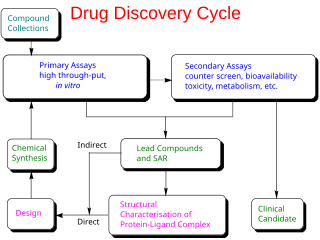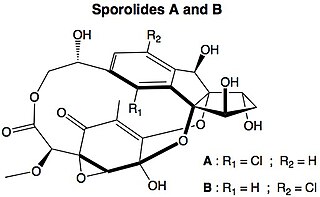
Bioprospecting is the exploration of natural sources for small molecules, macromolecules and biochemical and genetic information that could be developed into commercially valuable products for the agricultural, aquaculture, bioremediation, cosmetics, nanotechnology, or pharmaceutical industries. In the pharmaceutical industry, for example, almost one third of all small-molecule drugs approved by the U.S. Food and Drug Administration (FDA) between 1981 and 2014 were either natural products or compounds derived from natural products.

In the fields of medicine, biotechnology and pharmacology, drug discovery is the process by which new candidate medications are discovered.

Pharmacognosy is the study of plants and other natural substances as possible sources of drugs. The American Society of Pharmacognosy defines pharmacognosy as "the study of the physical, chemical, biochemical, and biological properties of drugs, drug substances, or potential drugs or drug substances of natural origin as well as the search for new drugs from natural sources".

A natural product is a chemical compound or substance produced by a living organism—that is, found in nature. In the broadest sense, natural products include any substance produced by life. Natural products can also be prepared by chemical synthesis and have played a central role in the development of the field of organic chemistry by providing challenging synthetic targets. The term natural product has also been extended for commercial purposes to refer to cosmetics, dietary supplements, and foods produced from natural sources without added artificial ingredients.
A biopharmaceutical, also known as a biologic(al) medical product, or biologic, is any pharmaceutical drug product manufactured in, extracted from, or semisynthesized from biological sources. Different from totally synthesized pharmaceuticals, they include vaccines, whole blood, blood components, allergenics, somatic cells, gene therapies, tissues, recombinant therapeutic protein, and living medicines used in cell therapy. Biologics can be composed of sugars, proteins, nucleic acids, or complex combinations of these substances, or may be living cells or tissues. They are isolated from living sources—human, animal, plant, fungal, or microbial. They can be used in both human and animal medicine.

Salinosporamide A (Marizomib) is a potent proteasome inhibitor being studied as a potential anticancer agent. It entered phase I human clinical trials for the treatment of multiple myeloma, only three years after its discovery in 2003. This marine natural product is produced by the obligate marine bacteria Salinispora tropica and Salinispora arenicola, which are found in ocean sediment. Salinosporamide A belongs to a family of compounds, known collectively as salinosporamides, which possess a densely functionalized γ-lactam-β-lactone bicyclic core.

Marine pharmacognosy is the investigation and identification of medically important plants and animals in the marine environment. It is a sub branch of terrestrial pharmacognosy. Generally the drugs are obtained from the marine species of bacteria, virus, algae, fungi and sponges. It is a relatively new field of study in western medicine, although many marine organisms were used in Traditional Chinese Medicine. It was not until 2004 that the first FDA approval of a drug came directly from the sea: ziconotide, which was isolated from a marine cone snail.

Sporolides A and B are polycyclic macrolides extracted from the obligate marine bacterium Salinispora tropica, which is found in ocean sediment. They are composed of a chlorinated cyclopenta[a]indene ring and a cyclohexenone moiety. They were the second group of compounds isolated from Salinispora, and were said to indicate the potential of marine actinomycetes as a source of novel secondary metabolites. The structures and absolute stereochemistries of both metabolites were elucidated using a combination of NMR spectroscopy and X-ray crystallography.

Capnellene is a naturally occurring tricyclic hydrocarbon derived from Capnella imbricata, a species of soft coral found in Indonesia. Since the 1970s, capnellene has been targeted for synthesis by numerous investigators due to its stereochemistry, functionality, and the interesting geometry of the carbon skeleton. Many alcohol derivatives of capnellene have demonstrated potential as a chemotherapeutic agent with antibacterial, anti-inflammatory and anti-tumor properties.
The salinosporamides are a group of closely related chemical compounds isolated from marine bacteria in the genus Salinispora. They possess a densely functionalized γ-lactam-β-lactone bicyclic core.
2,5-Diketopiperazine is an organic compound with the formula (NHCH2C(O))2. The compound features a six-membered ring containing two amide groups at opposite positions in the ring. It was first compound containing a peptide bond to be characterized by X-ray crystallography in 1938. It is the parent of a large class of 2,5-Diketopiperazines (2,5-DKPs) with the formula (NHCH2(R)C(O))2 (R = H, CH3, etc). They are ubiquitous peptide in nature. They are often found in fermentation broths and yeast cultures as well as embedded in larger more complex architectures in a variety of natural products as well as several drugs. In addition, they are often produced as degradation products of polypeptides, especially in processed foods and beverages. They have also been identified in the contents of comets.
Salinispora arenicola is an obligate marine actinomycetes bacterium species. It produces salinosporamide, a potential anti-cancer agent. The type strain is CNH-643T.
Salinispora tropica is an obligate marine actinomycetes bacterium species. It produces salinosporamide A and salinosporamide B, potential anti-cancer agents, as well as the polycyclic macrolides sporolide A and B. The type strain is CNB-440T.

Salinispora is a genus of obligately aerobic, gram-positive, non-acid-fast bacteria belonging to the family of Micromonosporaceae. They are heterotrophic, non-motile, and obligately grow under high osmotic/ionic-strength conditions. They are the first identified genus of gram-positive bacteria which has a high osmotic/ionic-strength requirement for survival. They are widely abundant in tropical marine sediments and were first identified in 2002. This genus of bacteria has potential biotechnological significance due to their production of novel secondary metabolites which can be used pharmaceutically.

Lacking an immune system, protective shell, or mobility, sponges have developed an ability to synthesize a variety of unusual compounds for survival. C-nucleosides isolated from Caribbean Cryptotethya crypta, were the basis for the synthesis of zidovudine (AZT), aciclovir (Cyclovir), cytarabine (Depocyt), and cytarabine derivative gemcitabine (Gemzar).
Streptomyces isolates have yielded the majority of human, animal, and agricultural antibiotics, as well as a number of fundamental chemotherapy medicines. Streptomyces is the largest antibiotic-producing genus of Actinomycetota, producing chemotherapy, antibacterial, antifungal, antiparasitic drugs, and immunosuppressants. Streptomyces isolates are typically initiated with the aerial hyphal formation from the mycelium.
Ureaplasma gallorale is a species of Ureaplasma, a genus of bacteria belonging to the family Mycoplasmataceae. It has been isolated from chickens and barnyard fowl. It possesses the sequence accession no. (16S rRNA gene) for the type strain: U62937. It is a commensal species with its host organism but has the ability to colonize and create infection. In the presence of virulence factors (H2O2, antigen proteins, etc.) is when these species start to over colonize. They have relatively small genomes, utilizing their host organisms natural processes to further their growth and survival. Nutrient required by the Ureaplasma species to continue metabolism are taken directly from the host. They proliferate in environments with a pH of 6.0-6.5 and a temperature of 35-37° C. These characteristics are common to most biological environments which is why Ureaplasma species regularly cause infection. These infections can be found in the genital and respiratory tracks of avian species (chickens and turkey). Ureaplasma gallorale infections cannot always be managed by the host due to the mechanisms the bacteria have adapted. A host will release immune signals of IgA molecules to the bacterial cells to signify infection but the Ureaplasmas can secrete an enzyme known as IgAse that destroys IgA, rendering the signal inactive and leaving the host susceptible to health concerns. These infections, known as the condition Ureaplasmosis, have further ramifications for the barnyard fowl such as low egg production, weight loss, reduced feed conversion efficiency and even death. These health issues are a serious concern in maintaining adequate production for the agricultural industry.

The branches of microbiology can be classified into pure and applied sciences. Microbiology can be also classified based on taxonomy, in the cases of bacteriology, mycology, protozoology, and phycology. There is considerable overlap between the specific branches of microbiology with each other and with other disciplines, and certain aspects of these branches can extend beyond the traditional scope of microbiology In general the field of microbiology can be divided in the more fundamental branch and the applied microbiology (biotechnology). In the more fundamental field the organisms are studied as the subject itself on a deeper (theoretical) level. Applied microbiology refers to the fields where the micro-organisms are applied in certain processes such as brewing or fermentation. The organisms itself are often not studied as such, but applied to sustain certain processes.
Cytophagales is an order of non-spore forming, rod-shaped, Gram-negative bacteria that move through a gliding or flexing motion. These chemoorganotrophs are important remineralizers of organic materials into micronutrients. They are widely dispersed in the environment, found in ecosystems including soil, freshwater, seawater and sea ice. Cytophagales is included in the Bacteroidota phylum.










